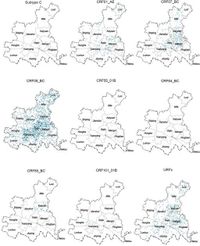A recent study in Honghe Prefecture, Yunnan Province, China, has unveiled critical patterns in HIV-1 transmission, shedding light on the ongoing epidemic in the region and offering insights for targeted interventions. Given the area's high incidence of HIV infection, understanding the transmission dynamics is essential for controlling the spread of the virus.
In 2022, researchers conducted a comprehensive molecular epidemiology study involving 1,004 newly diagnosed HIV-1 cases in Honghe. Out of these, 833 samples were successfully genotyped, revealing nine distinct HIV-1 genotypes. Among these, the CRF08_BC genotype was the most prevalent, accounting for 56.7% of the cases, followed by unique recombinant forms (URFs) at 17.8%, CRF07_BC at 13.9%, and CRF01_AE at 7.1%. The presence of highly diverse genotypes underscores the complexity of the HIV epidemic in this region, requiring detailed tracking and monitoring.
Molecular network analysis further illustrated varying clustering rates across different counties within the prefecture. Luxi County exhibited the highest clustering rate, while Honghe County had the lowest, a divergence that could influence intervention strategies. Notably, the study found that lower education levels correlated with higher clustering rates, suggesting that educational outreach could be a vital tool in combating this public health crisis.
Cross-county transmission trends were another significant finding of the study. Strong links between specific counties highlighted the interconnected nature of HIV transmission networks. The cohesive subgroup analysis identified three distinct spatial subdivisions, with one subgroup connecting eight counties running from northeast to southwest. The research indicated that individuals aged 50 to 59 years and those from ethnic minority groups were more likely to appear in these cross-county transmission patterns, signaling a need for targeted public health strategies aimed at these demographics.
In regard to drug resistance, the overall prevalence of HIV-1 pre-treatment drug resistance was recorded at 6.2%. Specific counties like Luxi, Hekou, and Yuanyang exhibited even higher rates, with Luxi County showing acritical 18.2% prevalence. This information is vital as high rates of drug resistance could jeopardize treatment efficacy and complicate ongoing efforts to manage the epidemic.
Historically, Honghe Prefecture has faced substantial challenges due to its complex epidemiological landscape. The region borders Vietnam and has historically been a pathway for drug trafficking, which has facilitated the spread of HIV among various populations. Addressing the epidemic has been a multi-faceted challenge, affecting not only public health but also social mobility and economic stability.
The study not only mapped the current landscape of HIV transmission but also highlighted the need for immediate action to address these findings. Given the substantial clustering rates and the socio-demographic factors influencing HIV transmission, tailored interventions focusing on education, testing, and community engagement will be essential in curbing the epidemic's growth.
In terms of methodology, researchers utilized advanced molecular epidemiology techniques to characterize HIV-1 transmission. They focused on genotyping and constructing molecular networks that visualize transmission relationships. These approaches have enabled a detailed understanding of transmission patterns and will aid public health officials in implementing strategic interventions.
In conclusion, this study presents significant findings that could inform future efforts to control HIV in Honghe Prefecture. As the region continues to struggle with high rates of HIV infection, understanding the dynamics of transmission through molecular epidemiological methods will be key to developing effective strategies. Interventions must be designed not only to treat existing infections but also to halt the spread of HIV, especially among vulnerable populations. The research underscores the urgency of a cohesive public health response that is adaptive to the socio-economic realities of the region.

